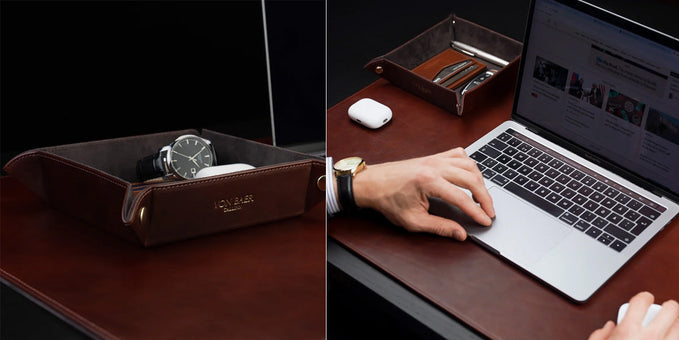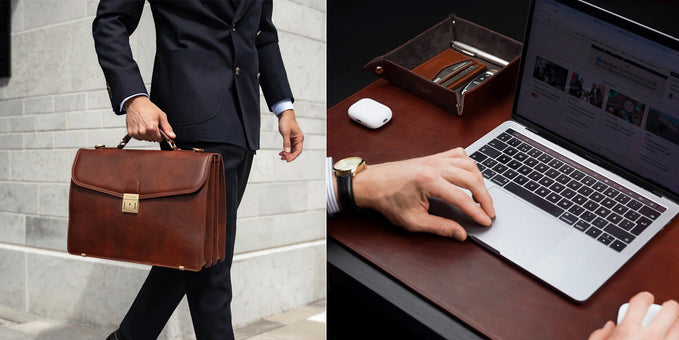Leather embossing

Embossed leather has been stamped with a pattern or design using a heat and high-pressure method.
There are many ways to do this. Alligator, ostrich, crocodile, geometric, floral, and Indian are a few examples.
Excellent to very high-grade skins arriving at the abattoir account for only 10-20%.
Embossing does not affect the quality of the leather and is entirely appropriate provided it is not being used to hide any defects that could shorten the life of the leather.
All Von Baer wallets can be embossed with your custom initials or image. You can learn more about that in the video below:
What is Leather Embossing?
Leather embossing is the technique of imprinting inscriptions, patterns, pictures, or logos onto the leather. It can be completed in a session or over time.
One method is leather completed and stamped instantly and another is where weights are applied to the leather. To create designs on animal skin, the leather is embossed. Sometimes embellishments cover the full surface of the skin.
Embossing Types
Blind embossing – This process is carried out without using color or pigments. This prevents the appearance of an extra coating or procedure and enhances the natural component of the animal hide.
Color embossing – The opposite of blind embossing. Leather is either stamped or pressed, and colors or pigments are applied.
Gold embossing – Leather embossed using gold leaf.
What Is Croc-Embossed Leather?
Crocodile-embossed leather, sometimes called croc-embossed, is made using cowhide. It replicates the appearance of reptile skin. The crocodile skin pattern is embossed onto the hide.
What Is Snake Embossed Leather?
Snake-embossed leather has a pattern resembling the skin of a snake.

Process of Leather Embossing
Leather is embossed using manual and mechanized tools. Industry equipment produces quick, immediate results. Moistened leather is stamped, and other instruments are used for surface clamping. Moist leather achieves a better outcome.
The posture is maintained for a few minutes to many hours. Uniformly applied chemicals and strict adherence to other guidelines is the ideal method for embossing leather.
Von Baer offers other personalization services too, like laser engraving. Browse all personalized bags below:
Why Emboss Leather?
Embossing gives leather items depth and character, adds design texture, and helps to make it stand out.
Leather fibers condense the deeper the patterns are imprinted; embossing creates a protective layer on leather that is untreated.
Learn about Von Baer Personalization.
How to Emboss leather
The right leather must be chosen. Due to the addition of oils and waxes, finished leather is resistant to tooling and embossing. For best results, unfinished leather should be embossed with fiber expansion and moisture absorption for more unusual patterns. A leather finish can be used once the job is completed.
Not all kinds of leather can be embossed, so if you’re going to do it yourself, make sure it’s an appropriate type. We recommend using top-grain or full-grain vegetable-tanned leather for your embossing projects as these will last a long time, smell like leather, and possess an earthly tone.
Embossing leather should be at least 2mm thick as embossing does not work well with thin leather.

Equipment and Materials
Without the correct equipment, artistry and knowledge are rendered useless. Tools are expensive and should be purchased if they are to be used long-term.
Preparing Your Workspace
Leather manufacturing is difficult without the correct tools. A solid comfortable desk will allow quicker completion and fewer health concerns. The height of the worktable should be adjustable to enable you to work seated or standing.
Related articles to read next:
- Leather
- Faux leather
- Vegan leather
- Bonded vs faux vs real leather
- Bonded leather
- Genuine leather
- Pleather
- Top grain leather
- Leather guide for beginners
- What is leather patina
- Vegetable tanned leather
- Leather tanning
- What is artificial leather?
- What is full grain leather
- Where does leather come from
- Mushroom leather
- Napa leather
Leather Embossing Glossary
You will need to be familiar with various craft phrases that mean different things in each medium for learning to emboss leather. This understanding will help you to design leather items that are beautiful in no time.
Embossing
The transfer of patterns to large sheets of leather. Requires specialized equipment. Used to conceal flaws that have not attained the fine-leather grade and boost value.
Dyes may be used to accentuate designs or may be left natural as in blind embossing, used for small and delicate words or logos. We recommend dye for large areas and elaborate designs. You will notice that embossed areas will have significantly darkened leather.
Stamping
The process of image transfer with an embossing machine and leather stamp. This procedure also involves hot foil stamping and branding. For a blind effect, use an arbor press with metal stamps.
Tooling
Craftsmen sometimes use embossing as a phrase interchangeable with stamping and tooling. Tooling requires a specific skill and is done by hand to achieve a professional look. It requires various instruments including stamping tools and works best on unprocessed leather, as do other manufacturing processes.
Engraving
Engraved leather can seem identical to embossed leather. However, engraving will require cutting through the surface and preservation using a finishing solution.
Casing
The moistening of vegetable-tanned leather for a crafter. The penetration of water expands the fibers and makes them responsive to embossing and stamping.
For a thickness of more than 3mm, leather should be soaked for a minute in water or sprayed. Thin leather should be cased with a damp sponge. Wipe with the sponge during the process to avoid drying out.
Related:
- Buying a leather bag
- How to burnish leather
- Is leather waterproof?
- How are leather wallets made?
- How to waterproof your leather bag
- How long does a leather bag last?
- How to clean leather bag
Best Tools for Embossing
Cutting Slab or Board
A stone slab (marble or granite may be used) is essential for leather embossing. If this is too expensive, a flat anvil may be used. This provides a firm surface which ensures a thorough even impression.
A rubber board placed under a stone slab or anvil is called a pounding board and is used to absorb stamping pressure. In addition, it helps when tracing designs, stamping directly, and pattern cutting as it has a tack where the pattern paper attaches although this is not recommended when working on thick leather which requires a hard surface.
Swivel Knife
This knife is ideal for leather embossing due to its being compact and sharp. Needed for carving or tooling. Can be angled, non-angled, ceramic, or hollow ground. These are the four types and a straight one is excellent for starting.
Mallet
Used for flattening leather in preparation for an embossed stamp or pushing to impress patterns. Mallet head size determines the pressure applied. Nylon, rawhide, or wooden mallets can be used according to preference.
Stamps
For embossing designs onto leather surfaces. Examples include beveled, backdrop, border, and simple basketweave. Additional stamps can be acquired, or bespoke stamps made to add a brand to work once experience is gained.
Extras
Also needed are sharp (ideally curved) scissors, a sponge, a knife or cutter, a ruler, and a French curve to start leather embossing. Finishing oils or dyes can be used on your creations for the desired aesthetic.
Conclusion
We hope you enjoyed our article on leather embossing.
If you have any questions or comments, contact us at info@vonbaer.com, or leave them in the comments.

Author: Albert Varkki
Albert Varkki is the co-founder of Von Baer. He understands leather products as a consumer, supplier, and a manufacturer, helping you with the inside knowledge you need, to choose the perfect leather product for you.
We strive for the highest editorial standards, and to only publish accurate information on our website.
Leave a Comment
Your email address will not be published.






